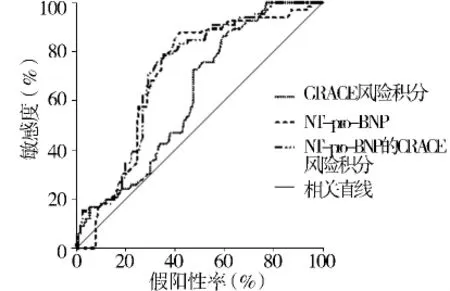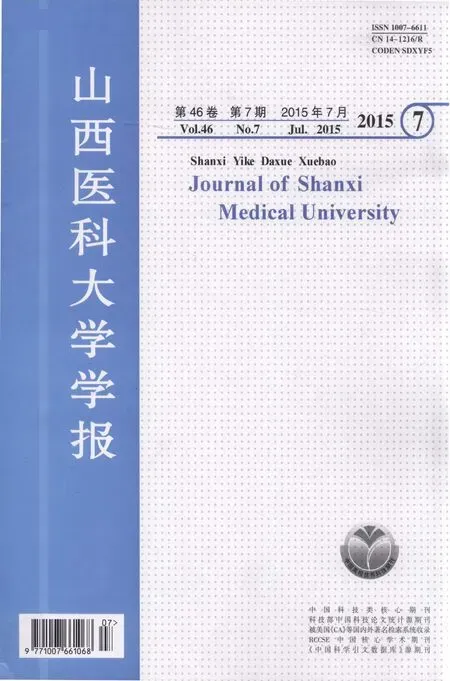NT-pro-BNP改良的GRACE风险评分对ACS患者12个月心血管事件的预测价值
赖国华,兰 军,涂 昌,刘瑞杰,蔡振明(南方医科大学附属东莞石龙人民医院心血管内科,东莞 523326;通讯作者,E-mail:312179908@qq.com)
冠心病是严重威害人类健康的常见病,而急性冠脉综合征(ACS)是冠心病的危急类型。由于急性冠脉综合征的严重程度有很大的差异,临床上对于它的风险分层是非常必要的。ACS的预后差别很大,影响预后的因素很多,探讨这些因素与预后的关系对ACS的防治有重要意义[1]。GRACE(全球急性冠状动脉事件注册)风险积分是最常用的用于风险分层的工具。有研究表明,氨基末端脑钠肽前体(NT-pro-BNP)与急性冠脉综合征患者的预后密切相关[2]。大规模临床研究验证GRACE风险评分有助于评价ACS患者的死亡风险及治疗决策,其不但能够预测患者住院期间病死率和心血管事件,对于患者远期病死率也有较好的预测价值[3,4]。相关的研究也表明应用NT-pro-BNP评估ACS患者12个月的预后时,发现高NT-pro-BNP组患者的12个月死亡率是低NT-pro-BNP组的10倍之多[5]。但是,NT-pro-BNP是否可以作为GRACE风险评分对ACS心血管事件评估的补充指标尚未见报道。本研究将NT-pro-BNP水平加入GRACE风险评分模型,探讨NT-pro-BNP对GRACE风险评分在ACS患者心血管事件预测的增补价值。
1 资料与方法
1.1 研究对象
选择2010-06~2012-06间在我院心内科住院治疗资料完整的ACS患者400例。所有患者均行冠脉造影,且入选患者须至少冠脉一主支或一重要分支狭窄≥50%,其中男264例,女136例。排除心脏以外其他脏器功能不全;急、慢性感染性疾病史、恶性肿瘤病史;急性脑血管意外;需干预病变血管(包括行心内介入治疗或外科搭桥)而未选择干预的患者等。
1.2 研究方法
收集所有患者入院时的临床资料,包括家族史、症状、年龄、心率、血压、既往病史、吸烟史、急性冠脉综合征的类型、Killip分级、服药情况等。所有患者均予标准冠心病二级预防治疗,并依据冠脉造影结果对需要干预的病变血管进行血运重建。根据患者入院时的临床资料计算GRACE风险评分,GRACE风险评分计算方法见表1[6]。患者的 NT-pro-BNP应用我院全自动生化分析仪测定。记录心血管事件发生情况。门诊复查或电话随访12个月心血管事件(包含复发心绞痛、心源性死亡、再发急性心肌梗死、心功能恶化和再入院的复合终点)发生情况。心血管事件定义包括:①复发性心绞痛:患者胸痛和/或胸闷症状术后已完全消失,而无明确诱因再次出现胸痛和/或胸闷,心电图、心肌酶学指标无明显改变;②心功能恶化:依照美国纽约心脏病协会(NYHA)心功能分级,患者术后随访时心功能分级较入组时加重≥Ⅰ级;③心源性死亡:不能明确由非心脏因素导致的死亡;④再发心肌梗死:指随访期间出现典型的胸痛和/或胸闷不适,症状持续超过30 min不能缓解,合并心电图、cTnT、CK、CK-MB动态变化达到AMI的诊断标准。

表1 GRACE风险积分细节Table 1 The details of GRACE risk score
1.3 统计学分析
首先应用ROC分析NT-pro-BNP对ACS患者12个月心血管事件的预测价值和界值。当AUC>0.5且P<0.05为差异有统计学意义。再通过Logistic回归分析评价NT-pro-BNP是否为12个月心血管事件的独立预测因素。然后建立NT-pro-BNP改良的GRACE风险评分模型。NT-pro-BNP以心肌酶升高为参考,通过二者OR比值确定NT-pro-BNP的分值。最后再通过ROC分析比较NT-pro-BNP改良的GRACE风险评分和常规的GRACE风险评分对心血管事件的预测价值。全部数据采用SPSS 17.0统计软件进行资料的统计分析。采用±s表示计量资料并进行描述。当P<0.05为差异有统计学意义。
2 结果
2.1 一般资料
纳入符合标准的急性冠脉综合征患者共400例,男264例,女136例,平均年龄(63.82±10.98)岁。其中不稳定型冠心病196例,非ST段抬高型心肌梗死60例,ST段抬高型心肌梗死144例。既往史:高血压病148例,糖尿病72例,高脂血症90例,吸烟237例。Killip分级:Ⅰ级240例,Ⅱ级123例,Ⅲ级37例,Ⅳ级0例。患者的NT-pro-BNP水平为(748±135)ng/ml,中位数为665 ng/ml。GRACE风险积分为132.26 ±30.30,中位数为131.00(98.00-226.00)。入院患者血清肌酐(82.93±13.78)μmoI/L,收缩压(137.58 ±26.55)mmHg。
2.2 NT-pro-BNP和12个月心血管事件的关系
12个月内的心血管事件的发生率是33.5%。ROC曲线分析显示,NT-pro-BNP水平预测12个月内的心血管事件的ROC曲线下面积为AUC 0.716(95%CI 0.731-0.980,P=0.000),其最佳界值为1 348.0 ng/ml,敏感度 84.1%,特异度 86.5%(见图1)。
2.3 NT-pro-BNP为12个月心血管事件的独立预测因素
通过Logistic回归分析,结果显示NT-pro-BNP为ACS患者12个月心血管事件的独立预测因素,其OR值为3.28。
2.4 NT-pro-BNP改良的GRACE风险评分和常规的GRACE风险评分对心血管事件的预测价值比较
为了评价NT-pro-BNP水平是否增强GRACE风险评分对ACS 12个月心血管事件预测的价值,将NT-pro-BNP加入GRACE风险评分模型中。NT-pro-BNP以心肌酶升高为参考,通过二者OR比值3.28∶1.12 确定 NT-pro-BNP 的分值为 42。经 ROC曲线分析,GRACE风险评分预测12个月心血管事件的界值是 127.5,AUC 0.623(95%CI 0.545-0.701),敏感度 72.7%,特异度 55%。NT-pro-BNP改良的GRACE风险评分预测12个月心血管事件的界值是146,AUC 0.761(95%CI 0.694-1.392),敏感度84%,特异度75%。GRACE风险评分和NT-pro-BNP改良的GRACE风险评分二者AUC比较差异有统计学意义(Z=2.62,P=0.02,见图 1)。
3 讨论
氨基末端利钠肽前体(NT-pro-BNP)是反映早期心功能损害敏感性和特异性较好的标志物,是诊断心脏衰竭行之有效的生物标志物[7]。它在各种左右心室功能和结构异常:如冠状动脉疾病(CAD)、严重的瓣膜病、心脏衰竭时将升高[8-13]。近年来研究表明NT-pro-BNP水平与急性心肌梗死后左室扩张和功能障碍的严重程度密切相关[14,15]。此外,NT-pro-BNP是一个敏感的急性心肌梗死患者预后的标志物[16],而且它被证明是预测患者的死亡率与急性冠脉综合征[17-20]。本研究评估入院时NT-pro-BNP对急性冠脉综合征患者12个月心血管事件预测价值,发现NT-pro-BNP与12个月心血管事件密切相关,不论是否经GRACE风险评分校正,高NT-pro-BNP均是12个月心血管事件的独立危险因素。

图1 GRACE风险评分和NT-pro-BNP水平预测12个月内的心血管事件Figure 1 Prediction of GRACE risk score and NT-pro-BNP levels for cardiovascular events within 12 months
本研究主要证明NT-pro-BNP有改善GRACE风险评分模型的能力。目前未见NT-pro-BNP有改善GRACE风险评分模型的研究报道。本研究将NT-pro-BNP加入GRACE风险评分模型重新进行分析,经ROC分析发现,NT-pro-BNP改良的GRACE风险评分对12个月心血管事件预测价值大于常规GRACE风险评分,差异有统计学意义。也就是说,NT-pro-BNP可以增强GRACE风险评分对12个月心血管事件预测价值。
综上,NT-pro-BNP可以增强GRACE风险评分对12个月ACS患者心血管事件预测价值。对ACS患者可应用NT-pro-BNP改良的GRACE风险评分模型进行风险分层,使患者在早期的有效治疗中获得最大收益。
[1]Bajaj RR,Goodman SG,Yan RT,et al.Treatment and outcomes of patients with suspected acute coronary syndromes in relation to initial diagnostic impressions(Insights from the Canadian GRACE and CANRACE)[J].Am J Cardiol,2013,111(2):202-207.
[2]Vasan RS.Biomarkers of cardiovascular disease:molecular basis and practical considerations[J].Circulation,2006,113:2335-2362.
[3]Wan ZF,Zhou D,Xue JH,et al.Combination of mean platelet volume and the GRACE risk score better predicts future cardiovascular events in patients with acute coronary syndrome[J].Platelets,2013,8:2326.
[4]Oncel RC,Ucar M,Karakas MS,et al.Relation of neutrophil-tolymphocyte ratio with grace risk score to inhospital cardiac events in patients with ST-segment elevated myocardial infarction[J].Clin Appl Thromb Hemost,2013,27:1-10.
[5]James SK,Lindahl B,Siegbahn A,et al.N-terminal-Pro-B-type natriuretic peptide and other risk markers for the separate prediction of mortality and subsequent myocardial infarction in patients with unstable coronary artery disease:a global utilization of strategies to open occluded arteries(GUSTO)-Ⅳ substudy[J].Circulation,2003,108(3):275-281.
[6]Granger CB,Goldberg RJ,Dabbous O,et al.Global Registry of A-cute Coronary Events Investigators.Predictors of hospital mortality in the global registry of acute coronary events[J].Arch Intern Med,2003,163(19):2345-2353.
[7]Doust JA,Glasziou PP,Pietrzak E,et al.A systematic review of the diagnostic accuracy of natriuretic peptides for heart failure[J].Arch Intern Med,2004,164:1978-1984.
[8]Yasue H,Yoshimura M,Sumida H,et al.Localization and mechanism of secretion of B-type natriuretic peptide in comparison with those of A-type natriuretic peptide in normal subjects and patients with heart failure[J].Circulation,1994,90(1):195-203.
[9]Ikeda T,Matsuda K,Itoh H,et al.Plasma levels of brain and atrial natriuretic peptides elevate in proportion to left ventricular end systolic wall stress in patients with aortic stenosis[J].Am Heart J,1997,133(3):307-314.
[10]Magga J,Marttila M,Mantymaa P,et al.Brain natriuretic peptide in plasma,atria,and ventricles of vasopressin and phenylephrineinfused conscious rats[J].Endocrinology,1994,134(6):2505-2515.
[11]Foote RS,Pearlman JD,Siegel AH,et al.Detection of exercise-induced ischemia by changes in B-type natriuretic peptides[J].J Am Coll Cardiol,2004,44(10):1980-1987.
[12]Ndrepepa G,Braun S,Mehilli J,et al.Plasma levels of n-terminal pro-brain natriuretic peptide in patients with coronary artery disease and relation to clinical presentation,angiographic severity,and left ventricular ejection fraction[J].Am J Cardiol,2005,95(5):553-557.
[13]Sabatine MS,Morrow DA,de Lemos JA,et al.Acute changes in circulating natriuretic peptide levels in relation to myocardial ischemia[J].J Am Coll Cardiol,2004,44(10):1988-1995.
[14]Bettencourt P,Ferreira A,Pardal-Oliveira N,et al.Clinical significance of brain natriuretic peptide in patients with postmyocardial infarction[J].Clin Cardiol,2000,23:921-927.
[15]Crilley JG,Farrer M.Left ventricular remodelling and brain natriuretic peptide after first myocardial infarction[J].Heart,2001,86:638-642.
[16]Morrow DA,Braunwald E.Future of biomarkers in acute coronary syndromes:moving toward a multimarker strategy[J].Circulation,2003,108:250-252.
[17]Omland T,Persson A,O’Brien R,et al.N-terminal pro-B-type natriuretic peptide and long-term mortality inacute coronary syndromes[J].Circulation,2002,106:2913-2918.
[18]de Lemos JA,Morrow DA,Bentley JH,et al.The prognostic value of B-type natriuretic peptide in patients with acute coronary syndromes[J].N Engl J Med,2001,345:1014- 1021.
[19]Mega JL,Morrow DA,De Lemos JA,et al.B-type natriuretic peptide at presentation and prognosis in patients with ST-segment elevation myocardial infarction:an ENTIRE-TIMI-23 substudy[J].J Am Coll Cardiol,2004,44:335-339.
[20]Jernberg T,James S,Lindahl B,et al.NT-proBNP in unstable coronary artery disease:experiences from the FAST,GUSTO IV and FRISC II trials[J].Eur J Heart Fail,2004,6:319- 325.

